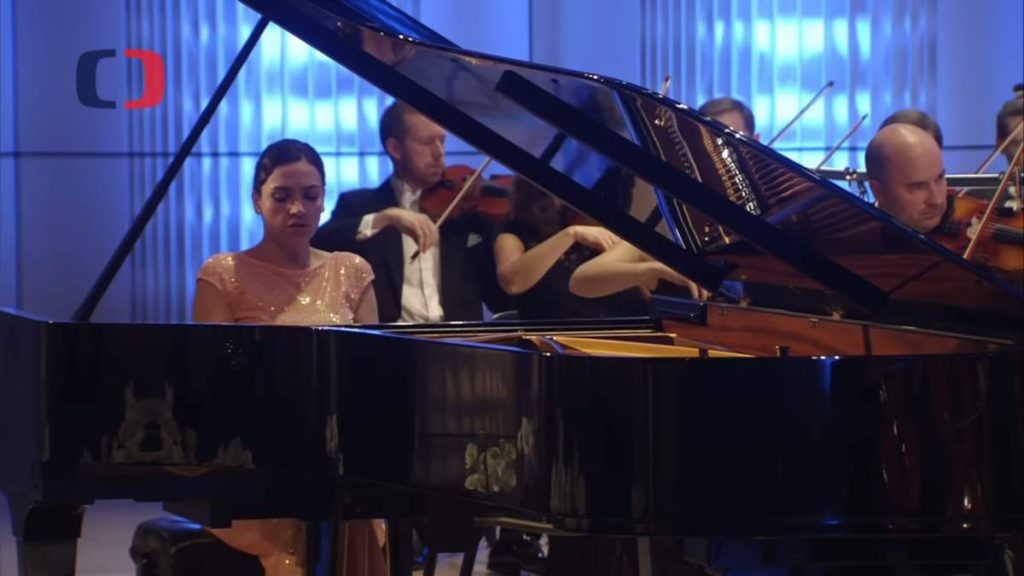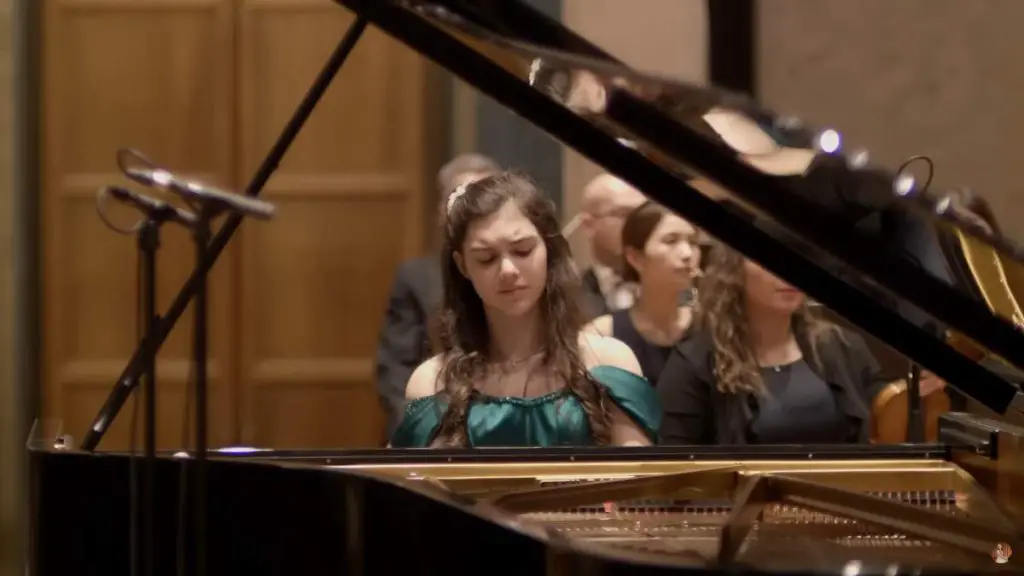Accompanied by the RTVE Symphony Orchestra, the German pianist Olga Scheps performs Ludwig van Beethoven’s Piano Concerto No. 3 in C minor, Op. 37. Conductor: Christoph König. This performance was recorded in February 2024.
Beethoven’s Piano Concerto No. 3
Ludwig van Beethoven’s Piano Concerto No. 3 in C minor, Op. 37, composed between 1800 and 1803, marks a significant evolution in his compositional style, reflecting the deepening of his musical expression and the beginning of his middle period. This concerto is noted for its dramatic intensity and the complexity of its structure, embodying a shift towards a more personal and expressive language that would characterize Beethoven’s later works.
The concerto was first performed on April 5, 1803, with Beethoven himself as the soloist. This performance was part of a landmark concert at the Theater an der Wien in Vienna, which also included the premieres of his Second Symphony and the oratorio “Christ on the Mount of Olives.” The Piano Concerto No. 3 is historically significant as it showcases Beethoven’s departure from the classical style of his predecessors, like Mozart and Haydn, towards a more romantic and individualistic expression.
The work is imbued with a sense of conflict and resolution, driven by its minor key, which was somewhat unusual for concertos at the time, giving it a dramatic and somewhat stormy character. This choice of key, C minor, a favorite of Beethoven’s, is used to great effect to create a powerful emotional narrative throughout the concerto. The orchestration is robust and innovative for its time, featuring interactions between the solo piano and the orchestra that was more integrated and dialogic than in many earlier concertos.
Throughout the concerto, Beethoven explores new possibilities in form and musical content, pushing the boundaries of the concerto genre. His use of the piano not just as a solo instrument but as an integral part of the orchestral texture was revolutionary and contributed significantly to the development of the concerto as a form of musical expression. The Piano Concerto No. 3 remains a staple of the concert repertoire, celebrated for its profound depth, innovative use of the solo piano, and its dramatic impact.

Movements
1. Allegro con brio
The first movement of Beethoven’s Piano Concerto No. 3 in C minor, Op. 37, marked “Allegro con brio,” sets a profound and dramatic tone for the entire concerto. This movement is characterized by its vigorous energy and the depth of its musical ideas, typical of Beethoven’s move toward more dramatic and expressive compositions.
The movement begins with an orchestral exposition that lays out the thematic material without the piano. This part features a strong, somber motif in C minor that immediately establishes the serious and intense character of the concerto. The orchestral introduction is thorough and sets a solid foundation for the thematic developments to follow.
When the piano enters, it does not simply repeat the themes introduced by the orchestra but elaborates and expands on them, displaying Beethoven’s innovative approach to the concerto form. The piano’s entrance is assertive and quickly becomes the driving force of the movement, with the soloist offering new material and engaging in a dynamic dialogue with the orchestra.
The development section is a hallmark of Beethoven’s compositional mastery, where he manipulates and varies the thematic material, exploring it in different keys and dynamics. This section builds tension and complexity, showcasing the piano’s capabilities in handling both lyrical lines and vigorous passages.
The recapitulation brings a return to the main themes by the orchestra, now further enriched and intensified by the piano. This leads to a dramatic climax, where the interplay between the solo piano and the orchestra reaches its peak.
The movement concludes with a coda that revisits the main themes with increased vigor and a final assertive statement from the piano, ending on a decisive note that firmly reestablishes the C minor tonality. This first movement not only sets the stage for the movements that follow but also encapsulates the dramatic and expressive capabilities of the piano concerto as a genre, driven by Beethoven’s unique vision and technical prowess.
2. Largo
The second movement of Beethoven’s Piano Concerto No. 3 in C minor, Op. 37, is marked “Largo” and offers a stark contrast to the dramatic and energetic first movement. This movement unfolds with serene and lyrical beauty, showcasing Beethoven’s ability to craft deeply expressive slow movements that communicate profound emotional depth.
Set in the key of E major, which provides a warm and luminous contrast to the stormy C minor of the first movement, the Largo opens with a gentle, flowing theme introduced by the strings. This theme sets a tranquil and contemplative mood that is then picked up and expanded by the piano. The piano’s entry is delicate and introspective, weaving intricate melodic lines that explore the thematic material with both subtlety and depth.
Throughout this movement, the interplay between the piano and the orchestra is characterized by a tender dialogue. The orchestration is restrained, allowing the piano’s lyrical voice to shine through. The strings often echo or subtly support the piano’s explorations, creating a lush, harmonious backdrop that enhances the overall sense of calm and introspection.
The Largo is notable for its expansive form and the spaciousness of its musical expression. Beethoven takes his time to let the themes develop slowly, giving the movement a spacious and almost meditative quality. This approach allows the music to breathe, drawing the listener into a deep emotional journey.
The movement gradually builds to a gentle climax, where the main theme is lovingly reiterated with a richness and depth that adds layers of meaning to the initial presentation. It then quietly recedes, ending as delicately as it began, leaving a lingering sense of peace and contemplation.
3. Rondo. Allegro – Presto
The third movement of Beethoven’s Piano Concerto No. 3 in C minor, Op. 37, marked “Rondo: Allegro,” serves as a vigorous and spirited finale to the concerto. This movement is characterized by its lively tempo and rhythmic vitality, bringing the concerto to a dynamic and exhilarating conclusion.
The movement opens with the piano introducing the main rondo theme, a catchy and rhythmic motif that sets the tone for the energetic exchanges to follow. This theme is bright and playful, contrasting with the more somber tones of the previous movements, particularly the introspective second movement. The rondo form allows for the main theme to return several times, interspersed with contrasting episodes that showcase both the piano’s virtuosity and Beethoven’s skill in thematic development.
The orchestral response to the piano’s statements is robust and engaging, with the full ensemble participating in the thematic dialogue. The orchestration is masterful, providing a rich tapestry of sounds that supports and complements the piano’s explorations. As the movement progresses, Beethoven introduces a series of episodes that vary in mood and style, each adding a new dimension to the movement’s character.
One of the most compelling aspects of this Rondo is Beethoven’s use of modulations and key changes to maintain tension and interest. These shifts provide a fresh context for the recurring rondo theme, keeping the movement vibrant and unpredictable. The piano part is particularly challenging, requiring rapid scales, arpeggios, and precise timing, all while maintaining the energetic pulse of the music.
The movement builds towards a climactic finale, where the main theme is presented in a triumphant and exuberant manner. This final statement of the theme leads to a brisk and joyous conclusion, ending the concerto on a high note that leaves both the performer and the audience invigorated.
Sources
- Piano Concerto No. 3 (Beethoven) on Wikipedia
- Piano Concerto No. 3, Op.37 (Beethoven, Ludwig van) on the International Music Score Library Project website

